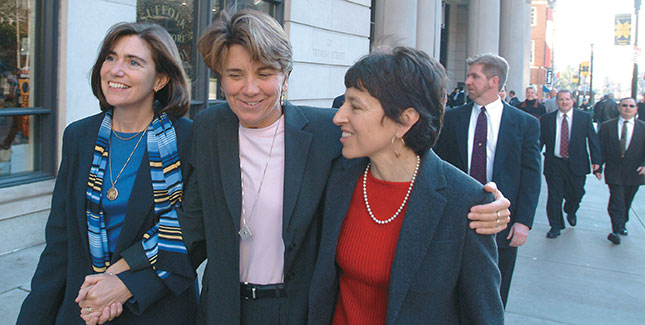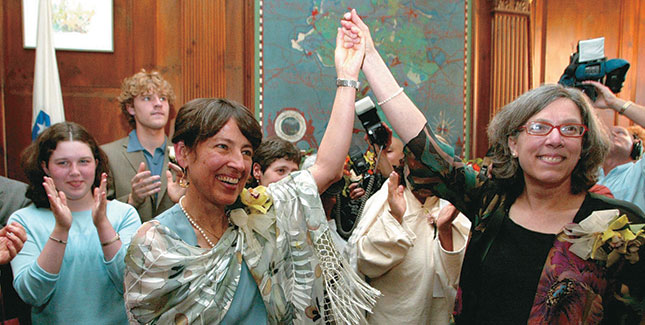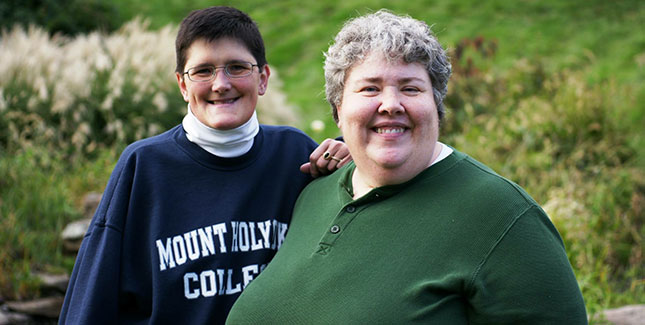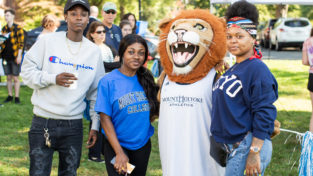We Are Family
In the legal battles for marriage equality, Mount Holyoke alumnae have formed a formidable (and sometimes unwitting) team
On an August afternoon in 2014, attorney Mary Hackett ’84 was at her laptop in her Pittsburgh home when a Facebook post from a classmate caught her eye. KC Maurer ’84, who had been president of their class at Mount Holyoke, had posted about her sister, Sabrina Maurer ’90. She was clearly upset.
“Normally Facebook and I are strictly social,” KC says. “I like seeing postings of people’s families, and their happy events, and dog and cat videos. I very rarely use Facebook as a bully pulpit.”
This time, though, she felt she had no choice. In the 2013 death of Kimberly Underwood ’91, Sabrina had lost the love of her life. Now, as if to add insult to injury, the bank where Sabrina and Kim had kept a safe-deposit box wasn’t allowing Sabrina to access it because—legally, at least—she wasn’t family.
Sabrina and Kim had met as undergrads at Mount Holyoke and met again by chance in 1996 when Sabrina, who is now a medical writer with a doctorate in clinical pharmacy, was doing her residency at the University of Pennsylvania. Working over the Labor Day weekend, Sabrina had noticed Kim’s name on a patient list and stopped in to say hello.
They reconnected, and after Kim left the hospital, the two spent more time together.
“We both remembered what we liked about the other person,” Sabrina says. “And she made me laugh.”

Sabrina Maurer ’90 (left) and Kimberly Underwood ’91 at their commitment ceremony with wedding party, including Sabrina’s sister KC Maurer ’84 (left). Photo courtesy of KC Maurer
They fell in love. When Sabrina took a job in New Jersey, Kim, who would later earn a doctoral degree in medical humanities, went with her. In 2001, they committed themselves to each other in a church ceremony in front of one hundred friends and relatives. A year later they moved together to Doylestown, Pennsylvania—“sort of the Northampton of Pennsylvania,” Sabrina says. Their families embraced their union. When Kim died from complications related to a congenital heart condition in November 2013, they had been living together for seventeen years.
“One of the things that really struck me,” KC recalls, “was the fact that even though Sabrina and Kim had been together for seventeen years and had had a commitment ceremony, powers of attorney and wills naming each other, and advance health care directives, and all the legal stuff they thought they needed, Sabrina in many cases was not considered next of kin.”
One of the things that really struck me was the fact that even though Sabrina and Kim had been together for seventeen years…Sabrina in many cases was not considered next of kin.
KC Maurer ’84
Sabrina had already been denied survivor benefits and life insurance. She had been forced to pay a stiff inheritance tax. Seeing her face yet another hassle was the last straw. In a posting her sister affectionately describes as “a little rant,” KC let fly:
Friends, if you are in a committed relationship, but not married, whether gay or straight, please know that if your partner dies, things financial[ly] will be very difficult, if your assets are entwined. Kim and Sabrina were together for 17 years, but PA wouldn’t let them marry before Kim died. So my sister has been dealing with these complicated financial issues for 8.5 months now and the state of PA has been wretched. The latest indignity wrought by the state of PA is that she was not allowed to inventory the contents of a joint safe deposit box today, despite her lawyer having notified the PA dept of revenue not once but twice. . . They made her specify a date and time, which was today, but when she arrived at the bank, it was a no-go. . . And yes, she and Kim had wills, powers of attorney, advanced directives, etc etc etc. But none of that matters because the one piece of paper the state of PA wants is the one that they would not grant to this committed, loving couple. It just isn’t right. That is all.
“That’s basically where this whole thing started,” KC says. “I just didn’t want it to happen to anybody else.”
In Pittsburgh, Mary Hackett, a partner at the law firm McGuireWoods LLP, read KC’s post and had an idea: What if Sabrina’s marriage could be declared valid by the state, even after Kimberly’s death? Hackett thought it might be possible. She keyed in an Internet search for “common law marriage in Pennsylvania.”
“My recollection was that if you entered into a common law marriage before 2005, Pennsylvania would recognize that marriage as valid,” Hackett says. “And sure enough, you just pull up the statute, and there it is.”
She sent a message to KC, who connected her with Sabrina. Soon they were discussing next steps.
The Right to Parent
Although Sabrina Maurer’s case would break new legal ground, her battle was made easier by the efforts of fellow Mount Holyoke alums on the front lines of the fight for marriage equality.
For example, in 1993, Ellen Wade ’70 and her wife, Maureen Brodoff, joined a case in Massachusetts to argue for Wade’s right to adopt their daughter, Kate.
“Maureen was the birth mother,” Wade says. “Kate was born in 1989, and at that point I had no legal relationship to our daughter at all. That was worrisome and felt a little unsafe. Fortunately nothing ever happened that raised any kind of problem about my not having a legal relationship with her. But it was a concern.”
They connected with now-prominent civil rights attorney Mary Bonauto, who was then a young lawyer with GLBTQ Legal Advocates and Defenders (GLAD), and joined their petition to a similar adoption case filed in the Massachusetts Probate and Family Court. When a judge denied the petition, GLAD appealed, and the Massachusetts Supreme Judicial Court heard the case. On September 10, 1993, the court ruled that Wade could adopt Kate, joining Brodoff as her parent and expanding the state’s definition of family.
I had no legal relationship to our daughter at all… Fortunately nothing ever happened that raised any kind of problem about my not having a legal relationship with her. But it was a concern.
Ellen Wade ’70
That victory was only the beginning. Eight years later, Wade and Brodoff were back in court. They made history again—this time with an assist from their daughter—as plaintiffs in Goodridge v. Department of Public Health, the Massachusetts court case that would be the first in which a US state’s highest court found that same-sex couples had the right to marry.
Though the legal landscape has shifted in recent years, in April of 2001 it seemed highly unlikely that a court in Massachusetts would conclude that same-sex marriage was allowed by the Massachusetts constitution.
“It even seemed farfetched to us when we were talking about getting involved,” Wade says. “It seemed like a worthy cause, and a good thing to do, but I wouldn’t have bet very much money on the chances of success.”
As the case progressed and the decision drew nearer, though, their hopes grew. When the court finally issued its ruling, Wade says, “it was a very joyous moment.”
Unfortunately, political opposition remained fierce, and the court stayed its ruling for six months, “to permit the legislature to take such action as it may deem appropriate in light of this opinion.”

Ellen Wade ’70 (right) with fellow plaintiffs in the case that legalized same-sex marriage in Massachusetts. Photo by Marilyn Humphries
It was during this waiting period, when the lobbying on both sides was most intense, that Wade’s daughter, Kate, decided to make a stand. In March of 2004, she spoke on the floor of the Massachusetts State House in Boston, registering the suburban normalcy of life with her moms—“softball, volleyball, karate, movies, mall”—and the frank bewilderment of a fifteen-year-old trying to understand why her parents couldn’t get married. She spoke of her realization that her parents weren’t considered equal to other parents, even though they “love each other and care for each other and me,” she said. “We’re family. Why doesn’t the state see that?”
A few months later, the state officially upheld the original ruling. Wade and Brodoff were married in Massachusetts on May 17, 2004, the first day same-sex marriage was legal there—or anywhere in the US. A Boston Globe photo from the ceremony shows them beaming, hand in hand, surrounded by news photographers.
We’re family. Why doesn’t the state see that?
Kate, daughter of Ellen Wade ’70 and Maureen Brodoff
The Massachusetts decision would be a game changer. In state after state, same-sex marriage was legitimized through legislation or legal challenge. In 2013, the US Supreme Court declared the 1996 Defense of Marriage Act unconstitutional. Exactly two years later, in Obergefell v. Hodges—with Mary Bonauto one of three attorneys presenting oral arguments for plaintiffs to the US Supreme Court—the right for same-sex couples to marry was enshrined in US law.
Of the Goodridge case, Wade says, “I think we helped to mold public opinion in Massachusetts. . . . Of course, to some degree, the court is going to make its own decision, regardless of public opinion. But I think we were able to help create the climate in which it was a little bit easier to decide the case the way that it did.”
Without the pioneering legal forays of couples like Wade and Brodoff, someone like Sabrina Maurer—working before the Obergefell decision, to validate her marriage after her wife’s death—might have faced a far thornier challenge. But Wade wasn’t the only Mount Holyoke alumna to have laid groundwork for Maurer’s lawsuit.

Ellen Wade ’70 (left) and Maureen Brodoff celebrated their marriage in 2004. Photo by Marilyn Humphries
A Related Case
When Sheila Vennell O’Rourke ’07 entered law school at Roger Williams in Rhode Island in 2009, she had already had some practice as an advocate. After graduating from Mount Holyoke, she had volunteered at a domestic violence hotline and with a social-justice organization in Northern Ireland. She decided to study law because she wanted to gain the skills to allow her to contribute on a broader scale.
In 2013, about a year before Mary Hackett saw KC Maurer’s Facebook post, O’Rourke was hired as a clerk for Judge John E. Jones III of the US District Court for the Middle District of Pennsylvania. She soon learned the judge had been assigned a case in which the plaintiffs were challenging Pennsylvania’s statutory ban on same-sex marriage.
“I was excited,” O’Rourke says, “just to know that would be going on in chambers. I had no expectation that I would be working on it because I would be the junior clerk at that point.”
As it turned out, O’Rourke was one of two clerks assigned to Whitewood v. Wolf, and she became a key member of the judge’s team.
“An opinion that issues from a judge’s chambers is a collaborative process,” Jones says. “The thought process is mine, and I own it in the end, but it’s a very collaborative process in the drafting. . . . Sheila was an uncommonly bright and good clerk and so she was a real force during her two years in chambers, and this case was no exception.”
As she studied the case, O’Rourke was deeply moved by the plaintiffs’ stories. Among them was a woman who had lost her wife to cancer. Though legally valid in Massachusetts, the couple’s marriage wasn’t recognized in Pennsylvania. Despite the fact that the plaintiff had left her job to care for her spouse, the official death certificate listed the deceased as never married, and her widow was forced to pay the inheritance tax levied on single people. On the death certificate, she was listed simply as “the informant.”
O’Rourke found that detail heartbreaking.
“The majority of my friends are in same-sex partnerships,” she says, “so it was close to home.”
She was gratified when Jones classified the plaintiffs as members of a group that had historically been subject to discrimination.
“Our court had to go through the analysis of determining what level of scrutiny to apply to classifications based on sexual orientation,” O’Rourke says, “and Judge Jones decided to apply intermediate scrutiny, which was a little bit going out on a limb. That was a proud moment for me.”
Jones’ ruling also meant that, about four months later, when Mary Hackett filed a petition in Pennsylvania to have Sabrina Maurer’s marriage to Kimberly Underwood recognized by the state, the way had been cleared for a sympathetic hearing. Whitewood v. Wolf is cited near the beginning of Hackett’s petition to the Bucks County court of common pleas.
Kim’s ashes are in three different places. She wanted them on her grandparents’ grave, she wanted them at Mount Holyoke, and she wanted them on our hill.
Sabrina Maurer ’90
“I had to have that,” Hackett says. “If I had not had [Whitewood], Pennsylvania’s statutory ban on same-sex marriages would still have been in place. So I had to have that decision, both to knock out that statute and to give the court here, in Sabrina’s case, grounds to ignore a prior Pennsylvania decision, years earlier, that had banned common law, same-sex marriage in the state. I needed the judge to grab hold of the recent decision and say, ‘I’m not going to follow that prior case.’”
Still, they didn’t expect to succeed.
On July 29, 2015, when the ruling in her case was handed down, Sabrina was incredulous. “I’m standing there, and we really didn’t know which way the judge was going to go,” she says, “and Mary had already prepared me. She said, ‘Look, we may not win with the trial court, and if we don’t we will appeal.’ When he ruled for us, I almost fell over. It didn’t seem real. And then the press started to call.”
But she had one more appointment to keep.
“After we got the decision,” Sabrina says, “I went up on the hill. Kim’s ashes are in three different places. She wanted them on her grandparents’ grave, she wanted them at Mount Holyoke, and she wanted them on our hill. So I went up the hill and told her. I’d like to think she’s proud of me.”
—By Abe Loomis
Abe Loomis is a freelance writer based in western Massachusetts. Contact him at abe.loomis@gmail.com.
October 12, 2016













Well done Abe! I especially loved the ending which is also a new beginning.